An Optimal Power Flow Solution of a System Integrated with Renewable Sources Using a Hybrid Optimizer
Abstract
:1. Introduction
2. Mathematical Formulation of OPF Problem
2.1. Cost Model of TGs
2.2. Cost Model of SPV Source
2.3. Cost Model of WE Source
2.4. Uncertainty Model of SPV and WE Sources
2.5. Objective Functions for Optimization
3. HPS-GWO for OPF Solution
4. Results and Discussion
4.1. Case 1: SPV and WE Source Cost vs. PDF Parameters
4.2. Case 2: Minimization of Total Generation Cost
4.3. Case 3: Minimization of Total Generation Cost with Carbon Tax on Emission
5. Conclusions
Author Contributions
Funding
Institutional Review Board Statement
Informed Consent Statement
Data Availability Statement
Conflicts of Interest
Nomenclature
| Abbreviations | |||
| OPF | Optimal power flow | Reserve cost coefficient for SPV source | |
| PSO | Particle swarm optimization | Penalty cost coefficient for SPV source | |
| GWO | Gray wolf optimization | Direct cost coefficient for WE source | |
| HPS-GWO | Hybrid particle swarm gray wolf optimizer | Reserve cost coefficient for WE source | |
| RES | Renewable energy sources | Penalty cost coefficient for WE source | |
| Probability density function | Probability of solar irradiance (W/m2) | ||
| p.u. | Per unit | Probability of wind speed(m/s) | |
| SPV | Solar photovoltaic | Lognormal PDF standard deviation | |
| WE | Wind energy | µ | Lognormal PDF mean |
| Symbols | G | Solar irradiance in W/m2 | |
| Thermal generator real power | Weibull PDF shape parameter | ||
| Wind energy source real power | Weibull PDF scale parameter | ||
| Solar photovoltaic source real power | Power losses in the network | ||
| Rated power output of SPV source | V.D | Cumulative voltage deviation | |
| Rated power output of WE source | Cemi | Emission cost | |
| SHADE | Success history based adaptive differential evolution | SF | Superiority of feasible solutions |
| Direct cost coefficient for SPV source | |||
References
- Rosales-Muñoz, A.A.; Grisales-Noreña, L.F.; Montano, J.; Montoya, O.D.; Perea-Moreno, A.J. Application of the Multiverse Optimization Method to Solve the Optimal Power Flow Problem in Direct Current Electrical Networks. Sustainability 2021, 13, 8703. [Google Scholar] [CrossRef]
- Shabbir, M.; Siddiqi, A.; Yapanto, L.; Tonkov, E.; Poltarykhin, A.; Pilyugina, A.; Petrov, A.; Foroughi, A.; Valiullina, D. Closed-Loop Supply Chain Design and Pricing in Competitive Conditions by Considering the Variable Value of Return Products Using the Whale Optimization Algorithm. Sustainability 2021, 13, 6663. [Google Scholar] [CrossRef]
- Khunkitti, S.; Siritaratiwat, A.; Premrudeepreechacharn, S. Multi-Objective Optimal Power Flow Problems Based on Slime Mould Algorithm. Sustainability 2021, 13, 7448. [Google Scholar] [CrossRef]
- Liao, Q.; Yang, J.; Zhou, Y. Sustainable Scheduling of an Automatic Pallet Changer System by Multi-Objective Evolutionary Algorithm with First Piece Inspection. Sustainability 2019, 11, 1498. [Google Scholar] [CrossRef] [Green Version]
- Barbato, A.; Capone, A. Optimization Models and Methods for Demand-Side Management of Residential Users: A Survey. Energies 2014, 7, 5787–5824. [Google Scholar] [CrossRef]
- Ngoko, B.O.; Sugihara, H.; Funaki, T. Optimal power flow considering line-conductor temperature limits under high penetration of intermittent renewable energy sources. Int. J. Electr. Power Energy Syst. 2018, 101, 255–267. [Google Scholar] [CrossRef]
- Morshed, M.J.; Ben Hmida, J.; Fekih, A. A probabilistic multi-objective approach for power flow optimization in hybrid wind-PV-PEV systems. Appl. Energy 2018, 211, 1136–1149. [Google Scholar] [CrossRef]
- Momoh, J.A.; El-Hawary, M.E.; Adapa, R. A review of selected optimal power flow literature to 1993. II. Newton, linear programming and interior point methods. IEEE Trans. Power Syst. 1999, 14, 105–111. [Google Scholar] [CrossRef]
- Momenitabar, M.; Mattson, J. A Multi-Objective Meta-Heuristic Approach to Improve the Bus Transit Network: A Case Study of Fargo-Moorhead Area. Sustainability 2021, 13, 10885. [Google Scholar] [CrossRef]
- Coskun, S.; Huang, C.; Zhang, F. Quadratic programming-based cooperative adaptive cruise control under uncertainty via receding horizon strategy. Trans. Inst. Meas. Control. 2021. [Google Scholar] [CrossRef]
- Alhumaid, Y.; Khan, K.; Alismail, F.; Khalid, M. Multi-Input Nonlinear Programming Based Deterministic Optimization Framework for Evaluating Microgrids with Optimal Renewable-Storage Energy Mix. Sustainability 2021, 13, 5878. [Google Scholar] [CrossRef]
- Carli, R.; Dotoli, M. Energy scheduling of a smart home under nonlinear pricing. In Proceedings of the 53rd IEEE Conference on Decision and Control, Los Angeles, CA, USA, 15–17 December 2014; pp. 5648–5653. [Google Scholar] [CrossRef]
- Biswas, P.P.; Suganthan, P.N.; Mallipeddi, R.; Amaratunga, G.A. Optimal power flow solutions using differential evolution algorithm integrated with effective constraint handling techniques. Eng. Appl. Artif. Intell. 2018, 68, 81–100. [Google Scholar] [CrossRef]
- El Ela, A.A.; Abido, M.; Spea, S. Optimal power flow using differential evolution algorithm. Electr. Power Syst. Res. 2010, 80, 878–885. [Google Scholar] [CrossRef]
- Taher, M.A.; Kamel, S.; Jurado, F.; Ebeed, M. An improved moth-flame optimization algorithm for solving optimal power flow problem. Int. Trans. Electr. Energy Syst. 2019, 29, e2743. [Google Scholar] [CrossRef]
- Osman, M.; Abo-Sinna, M.; Mousa, A.A. A solution to the optimal power flow using genetic algorithm. Appl. Math. Comput. 2004, 155, 391–405. [Google Scholar] [CrossRef]
- Sulaiman, M.H.; Mustaffa, Z.; Mohamad, A.J.; Saari, M.M.; Mohamed, M.R. Optimal power flow with stochastic solar power using barnacles mating optimizer. Int. Trans. Electr. Energy Syst. 2021, 31, e12858. [Google Scholar] [CrossRef]
- Abido, M.A. Optimal power flow using particle swarm optimization. Int. J. Electr. Power Energy Syst. 2002, 24, 563–571. [Google Scholar] [CrossRef]
- Elattar, E.E. Optimal Power Flow of a Power System Incorporating Stochastic Wind Power Based on Modified Moth Swarm Algorithm. IEEE Access 2019, 7, 89581–89593. [Google Scholar] [CrossRef]
- Dogra, R.; Gupta, N. Glowworm Swarm Optimization technique for optimal power flow. Adv. Electr. Electron. Eng. 2014, 4, 155–160. [Google Scholar]
- Duman, S.; Güvenç, U.; Sönmez, Y.; Yörükeren, N. Optimal power flow using gravitational search algorithm. Energy Convers. Manag. 2012, 59, 86–95. [Google Scholar] [CrossRef]
- Helmi, A.M.; Carli, R.; Dotoli, M.; Ramadan, H.S. Ramadan. Efficient and Sustainable Reconfiguration of Distribution Networks via Metaheuristic Optimization. IEEE Trans. Autom. Sci. Eng. 2021, 1–17. [Google Scholar] [CrossRef]
- Muhammad, M.A.; Mokhlis, H.; Naidu, K.; Amin, A.; Franco, J.F.; Othman, M. Distribution Network Planning Enhancement via Network Reconfiguration and DG Integration Using Dataset Approach and Water Cycle Algorithm. J. Mod. Power Syst. Clean Energy 2020, 8, 86–93. [Google Scholar] [CrossRef]
- Radosavljević, J.; Klimenta, D.; Jevtić, M.; Arsić, N. Optimal Power Flow Using a Hybrid Optimization Algorithm of Particle Swarm Optimization and Gravitational Search Algorithm. Electr. Power Compon. Syst. 2015, 43, 1958–1970. [Google Scholar] [CrossRef]
- Biswas, P.P.; Suganthan, P.; Amaratunga, G.A. Optimal power flow solutions incorporating stochastic wind and solar power. Energy Convers. Manag. 2017, 148, 1194–1207. [Google Scholar] [CrossRef]
- Reddy, S.S. Optimal power flow using hybrid differential evolution and harmony search algorithm. Int. J. Mach. Learn. Cybern. 2018, 10, 1077–1091. [Google Scholar] [CrossRef]
- Li, Y.; Wang, Y.; Li, B. A hybrid artificial bee colony assisted differential evolution algorithm for optimal reactive power flow. Int. J. Electr. Power Energy Syst. 2013, 52, 25–33. [Google Scholar] [CrossRef]
- Birogul, S. Hybrid Harris Hawk Optimization Based on Differential Evolution (HHODE) Algorithm for Optimal Power Flow Problem. IEEE Access 2019, 7, 184468–184488. [Google Scholar] [CrossRef]
- Yao, F.; Dong, Z.Y.; Meng, K.; Xu, Z.; Iu, H.H.-C.; Wong, K.P. Quantum-Inspired Particle Swarm Optimization for Power System Operations Considering Wind Power Uncertainty and Carbon Tax in Australia. IEEE Trans. Ind. Inform. 2012, 8, 880–888. [Google Scholar] [CrossRef]
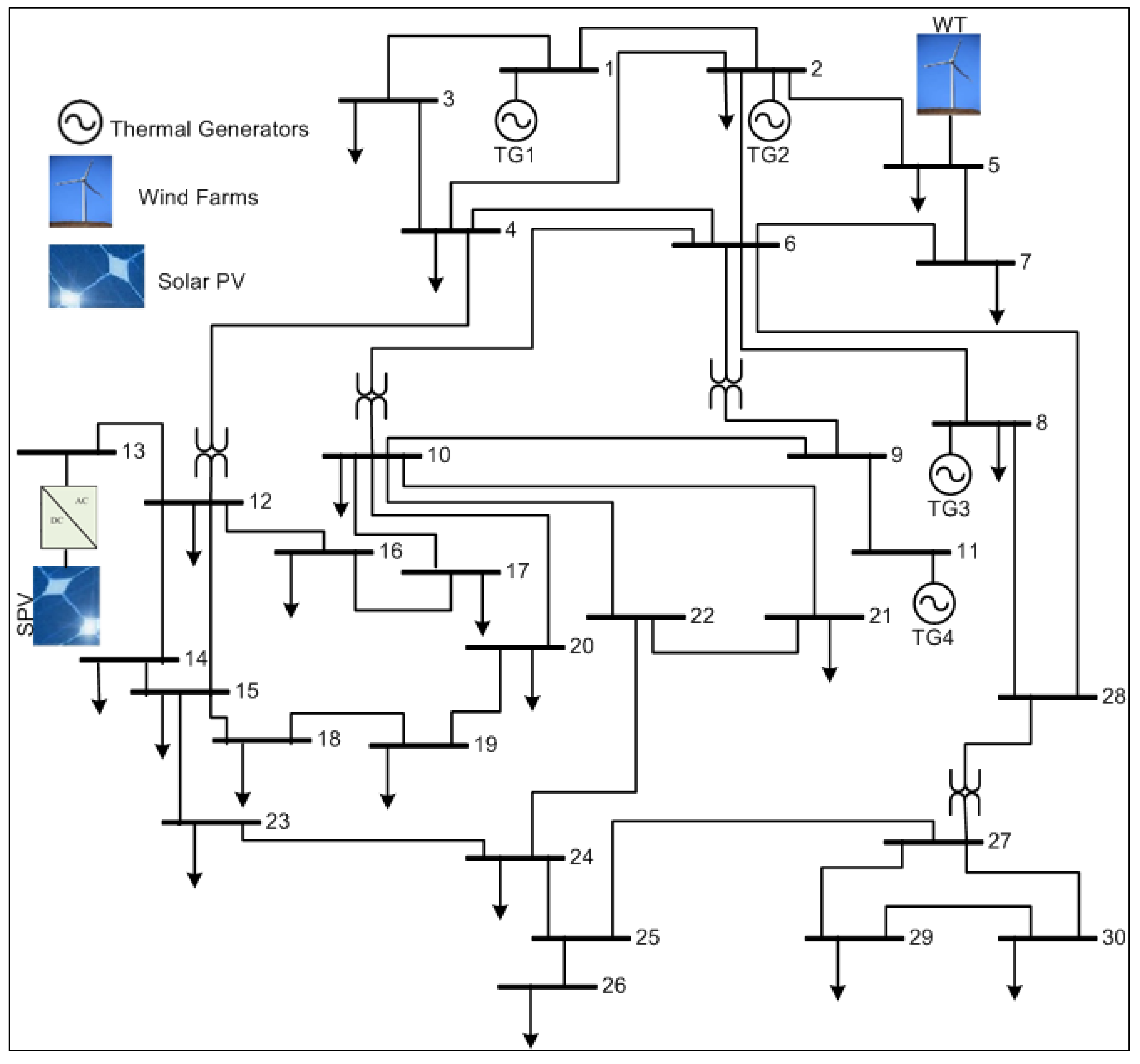
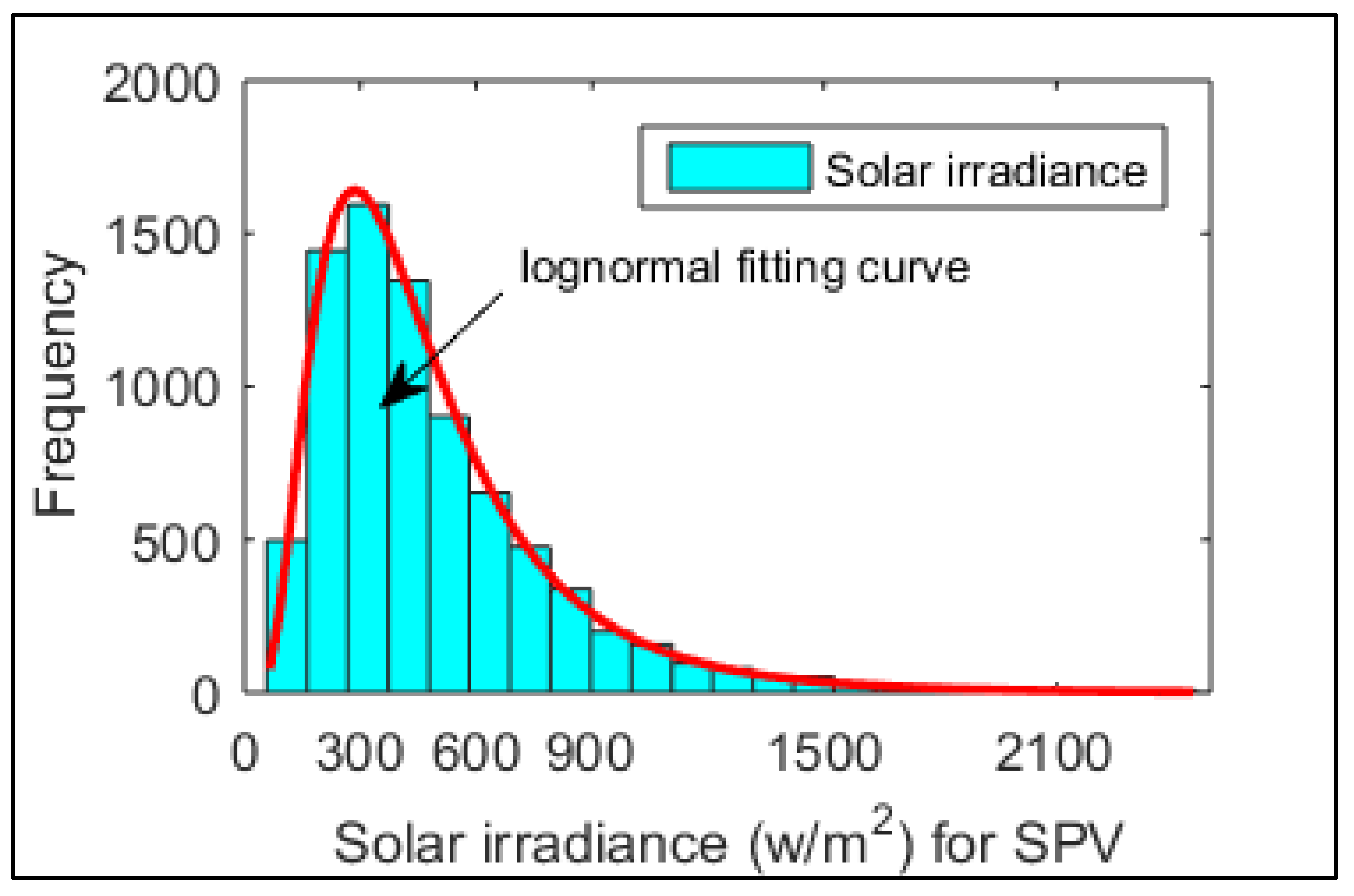
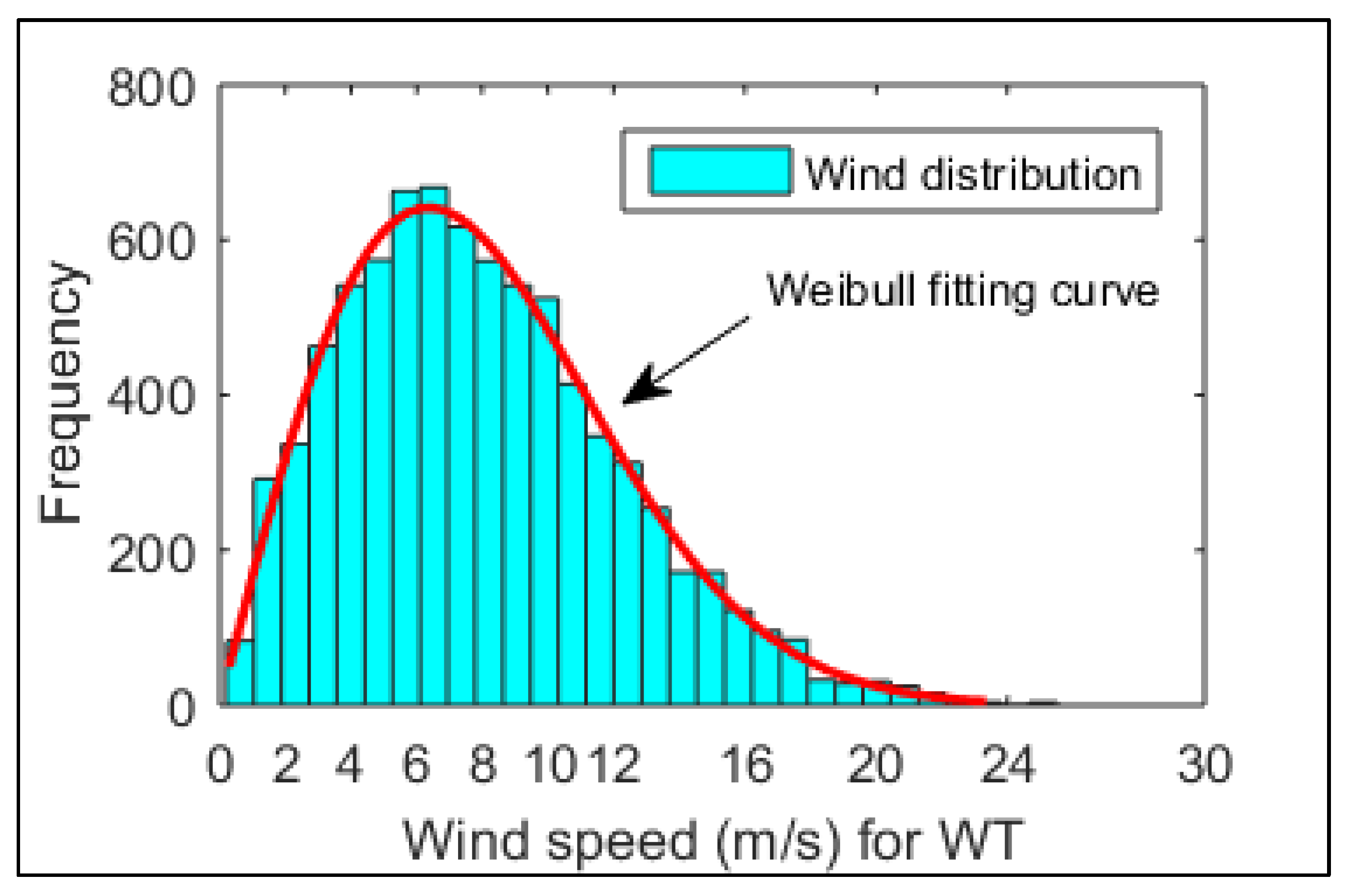
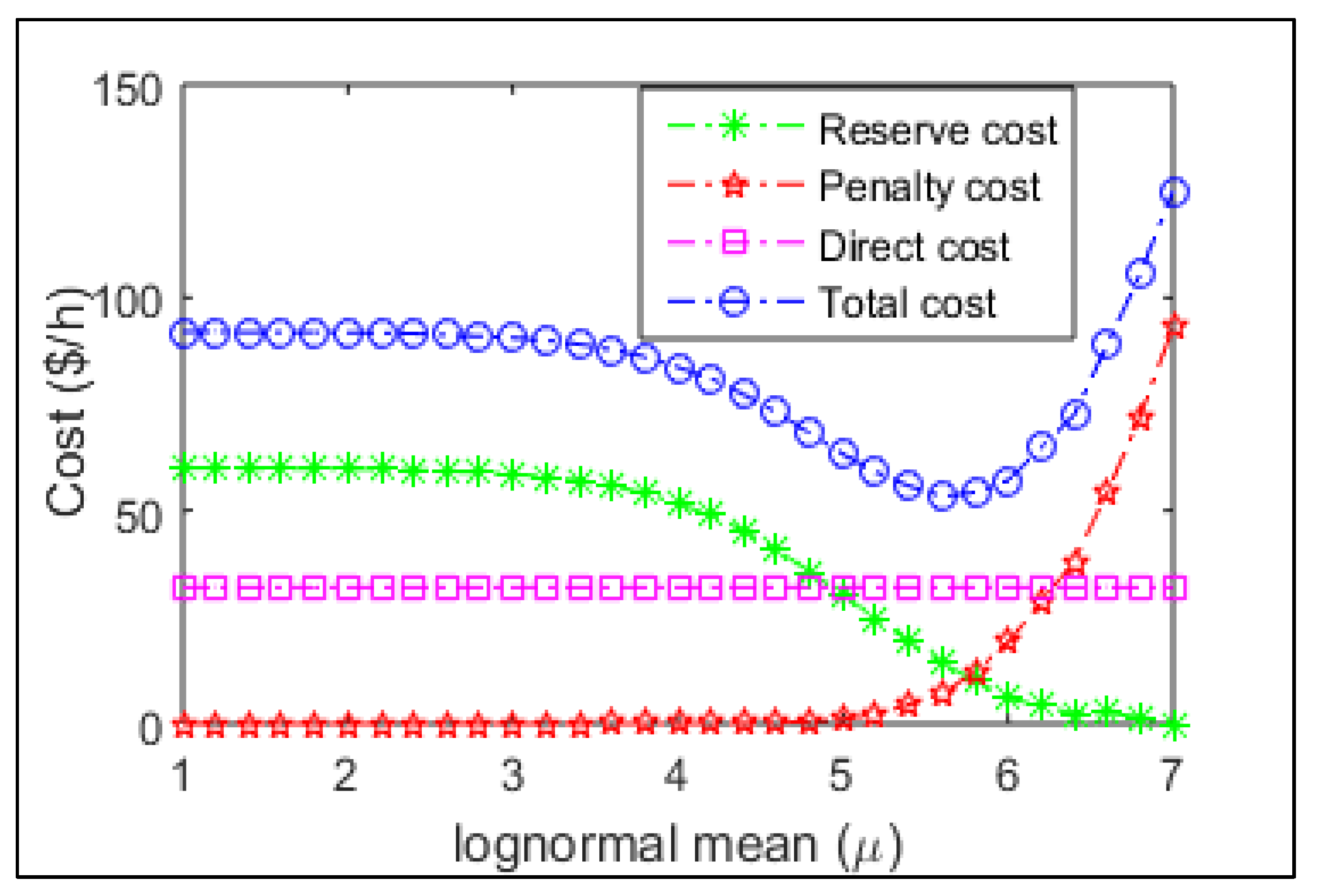

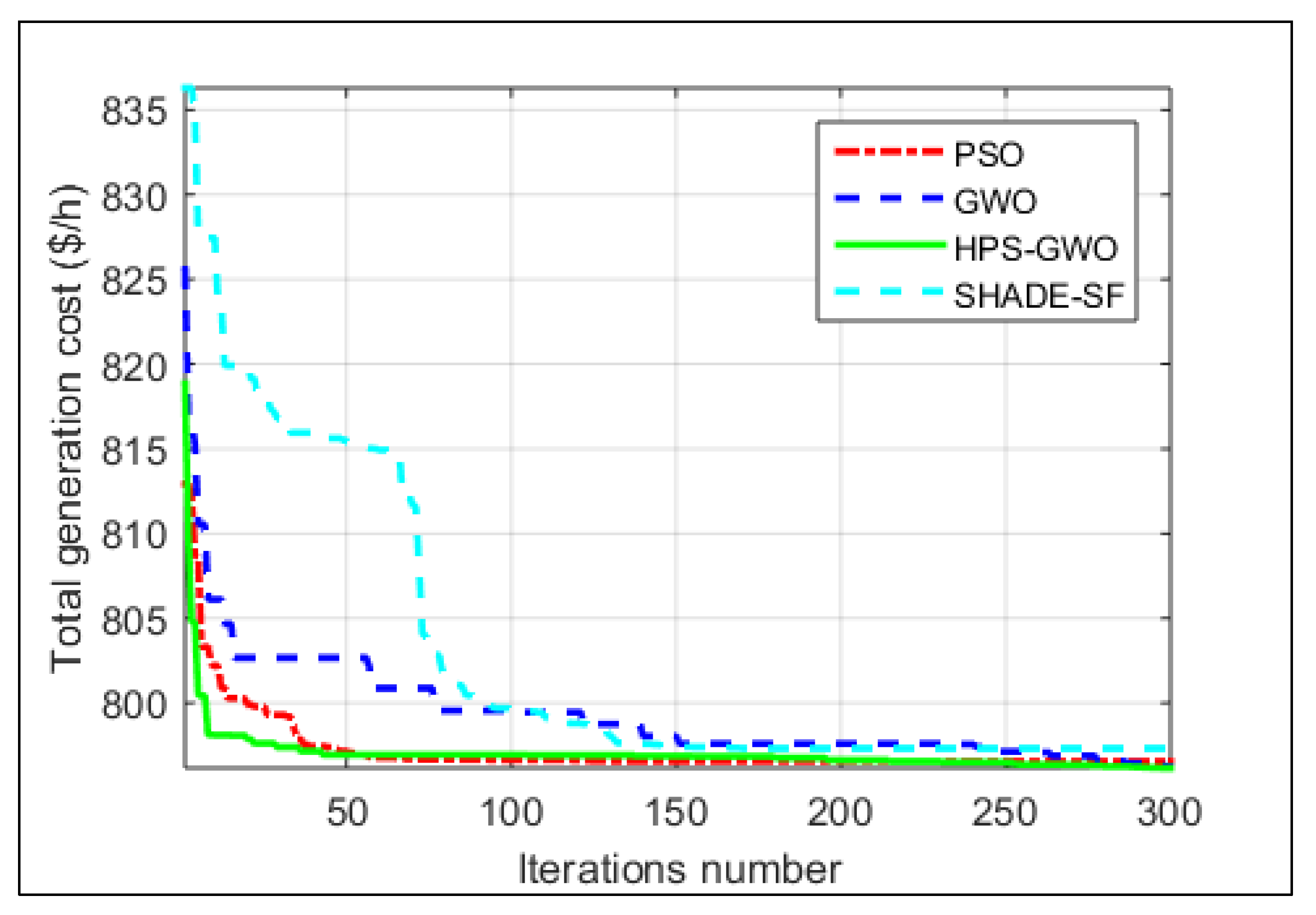
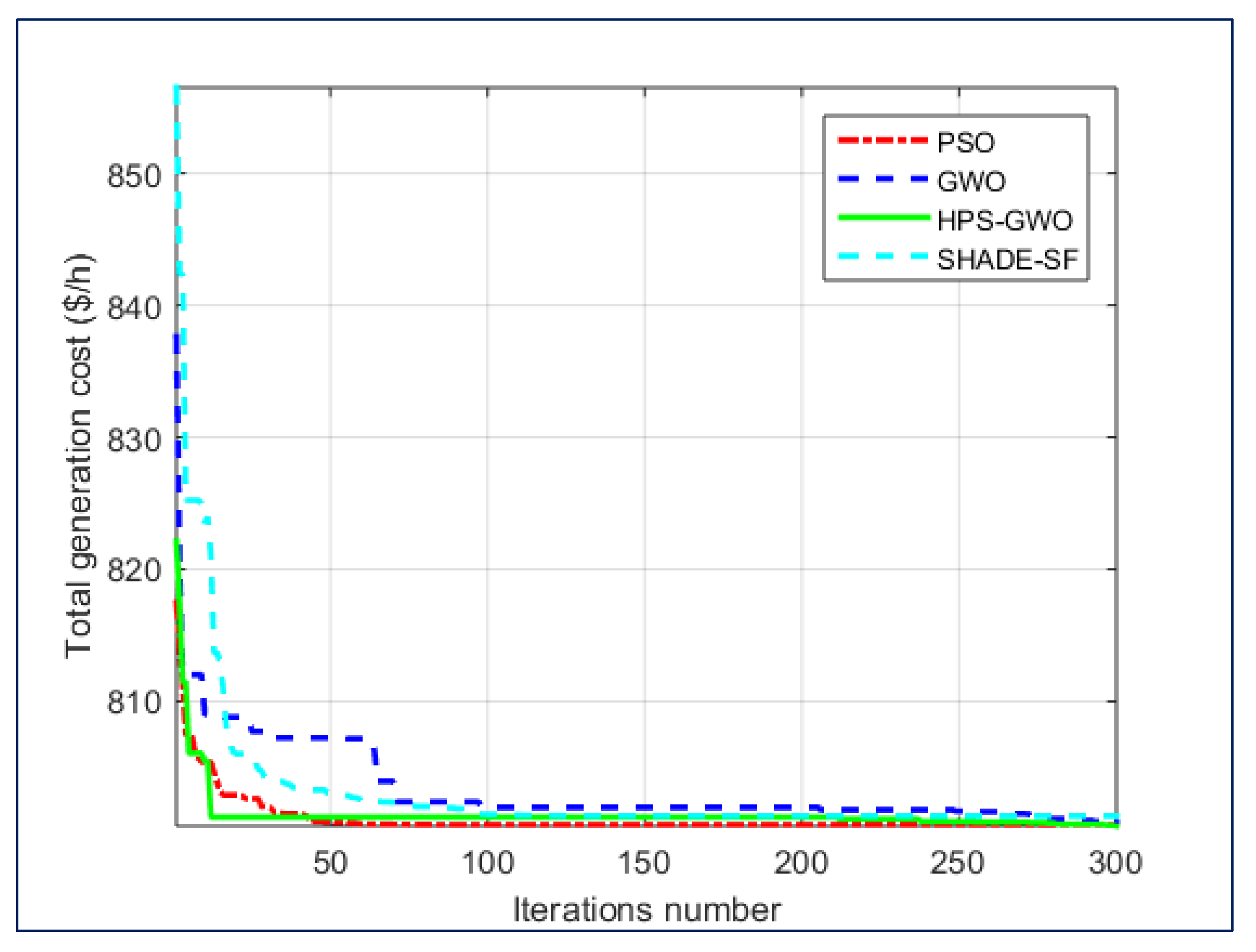
| Bus# | a | b | c | d | µ | Ω | e | α | β | γ | ||
|---|---|---|---|---|---|---|---|---|---|---|---|---|
| 1 | 50 | 200 | 0 | 2.00 | 0.00375 | 18 | 0.0002 | 2.857 | 0.037 | 4.091 | −5.554 | 6.490 |
| 2 | 20 | 80 | 0 | 1.75 | 0.0175 | 16 | 0.0005 | 3.333 | 0.038 | 2.543 | −6.047 | 5.638 |
| 8 | 10 | 35 | 0 | 3.25 | 0.00834 | 12 | 0.002 | 2.00 | 0.045 | 5.326 | −3.550 | 3.380 |
| 11 | 10 | 30 | 0 | 3.00 | 0.025 | 13 | 0.00001 | 8.00 | 0.042 | 4.258 | −5.094 | 4.586 |
| Bus # | Pwr (MW) | Scale Factor (c) | Shape Factor (k) | Weibull Mean | Direct Cost Coeff. | Reserve Cost Coeff. | Penalty Cost Coeff. |
|---|---|---|---|---|---|---|---|
| 5 | 75 | 9 | 2 | V = 7.976 m/s | Kgw,5 = 1.6 | KRw,5 = 3 | KPw,5 = 1.5 |
| Bus # | Psr (MW) | Mean (µ) | Standard Deviation (σ) | Lognormal Mean | Coefficient for Direct Cost | Coefficient for Reserve Cost | Coefficient for Penalty Cost |
|---|---|---|---|---|---|---|---|
| 13 | 50 | 5.8 | 0.6 | G = 483 W/m2 | Khs,13 = 1.6 | KRs,13 = 3 | KPsw,13 = 1.5 |
| Parameters | Lower Limit | Upper Limit | PSO | GWO | HPS-GWO | SHADE-SF | |
|---|---|---|---|---|---|---|---|
| Swing Generator | PTG1(MW) | 50 | 140 | 134.908 | 135.661 | 135.112 | 124.156 |
| Control Variables | PTG2(MW) | 20 | 80 | 43.546 | 41.029 | 42.645 | 34.883 |
| PWT5(MW) | 0 | 75 | 50.845 | 51.001 | 49.779 | 46.985 | |
| PTG8(MW) | 10 | 35 | 10.000 | 10.610 | 10.000 | 10.000 | |
| PTG11(MW) | 10 | 30 | 10.000 | 10.094 | 10.025 | 30.000 | |
| PSPV13(MW) | 0 | 50 | 40.085 | 41.361 | 42.018 | 42.830 | |
| V1(p.u.) | 0.95 | 1.10 | 1.100 | 1.100 | 1.100 | 1.070 | |
| V2(p.u.) | 0.95 | 1.10 | 1.901 | 1.089 | 1.091 | 1.056 | |
| V5(p.u.) | 0.95 | 1.10 | 1.071 | 1.074 | 1.071 | 1.035 | |
| V8(p.u.) | 0.95 | 1.10 | 1.096 | 1.100 | 1.097 | 1.097 | |
| V11(p.u) | 0.95 | 1.10 | 1.100 | 1.094 | 1.100 | 1.100 | |
| V13(p.u.) | 0.95 | 1.10 | 1.100 | 1.095 | 1.092 | 1.053 | |
| Generator Reactive Power | QTG1(MVAr) | −20 | 150 | −12.332 | −13.435 | −6.721 | −3.397 |
| QTG2(MVAr) | −20 | 60 | 18.230 | 27.184 | 4.773 | 10.439 | |
| QWT5(MVAr) | −30 | 35 | 24.611 | 18.841 | 35.000 | 21.969 | |
| QTG8(MVAr) | −15 | 40 | 40.000 | 40.000 | 40.000 | 40.000 | |
| QTG11(MVAr) | −10 | 50 | 18.464 | 17.998 | 17.862 | 30.000 | |
| QSPV13(MVAr) | −20 | 25 | 23.689 | 22.144 | 22.235 | 16.357 | |
| Objective Functions | Gen. cost ($/h) | - | - | 796.556 | 796.254 | 796.164 | 797.324 |
| Emission (ton/h) | - | - | 0.19592 | 0.19703 | 0.19628 | 0.924 | |
| Ploss (MW) | - | - | 5.9845 | 5.9841 | 5.9832 | 5.453 |
| Parameters | Lower Limit | Upper Limit | PSO | GWO | HPS-GWO | SHADE-SF | |
|---|---|---|---|---|---|---|---|
| Swing Generator | PTG1(MW) | 50 | 140 | 134.908 | 135.119 | 134.400 | 125.123 |
| Control Variables | PTG2(MW) | 20 | 80 | 42.564 | 40.830 | 42.205 | 38.093 |
| PWE5(MW) | 0 | 75 | 50.566 | 51.442 | 51.211 | 48.562 | |
| PTG8(MW) | 10 | 35 | 10.000 | 10.166 | 10.294 | 10.000 | |
| PTG11(MW) | 10 | 30 | 10.000 | 10.000 | 10.020 | 30.000 | |
| PSPV13(MW) | 0 | 50 | 41.341 | 41.969 | 40.525 | 37.094 | |
| V1(p.u.) | 0.95 | 1.10 | 1.100 | 1.100 | 1.100 | 1.071 | |
| V2(p.u.) | 0.95 | 1.10 | 1.090 | 1.089 | 1.091 | 1.057 | |
| V5(p.u.) | 0.95 | 1.10 | 1.071 | 1.071 | 1.074 | 1.036 | |
| V8(p.u.) | 0.95 | 1.10 | 1.099 | 1.092 | 1.089 | 1.085 | |
| V11(p.u) | 0.95 | 1.10 | 1.100 | 1.098 | 1.100 | 1.100 | |
| V13(p.u.) | 0.95 | 1.10 | 1.100 | 1.100 | 1.100 | 1.051 | |
| Generator Reactive Power | QTG1(MVAr) | −20 | 150 | −12.297 | −13.141 | −17.772 | −3.151 |
| QTG2(MVAr) | −20 | 60 | 18.114 | 14.729 | 37.803 | 10.776 | |
| QWE5(MVAr) | −30 | 35 | 24.626 | 27.588 | 9.715 | 21.943 | |
| QTG8(MVAr) | −15 | 40 | 40.000 | 40.000 | 40.000 | 40.000 | |
| QTG11(MVAr) | −10 | 50 | 18.443 | 18.902 | 18.835 | 30.000 | |
| QSPV13(MVAr) | −20 | 25 | 23.761 | 25.000 | 24.052 | 15.664 | |
| Objective functions | Gen. cost ($/h) | - | - | 800.6517 | 800.8232 | 800.5614 | 801.320 |
| Emission (ton/h) | - | - | 0.19597 | 0.19634 | 0.19524 | 0.997 | |
| Ploss (MW) | - | - | 5.9787 | 6.0013 | 5.9436 | 5.471 |
Publisher’s Note: MDPI stays neutral with regard to jurisdictional claims in published maps and institutional affiliations. |
© 2021 by the authors. Licensee MDPI, Basel, Switzerland. This article is an open access article distributed under the terms and conditions of the Creative Commons Attribution (CC BY) license (https://creativecommons.org/licenses/by/4.0/).
Share and Cite
Riaz, M.; Hanif, A.; Masood, H.; Khan, M.A.; Afaq, K.; Kang, B.-G.; Nam, Y. An Optimal Power Flow Solution of a System Integrated with Renewable Sources Using a Hybrid Optimizer. Sustainability 2021, 13, 13382. https://doi.org/10.3390/su132313382
Riaz M, Hanif A, Masood H, Khan MA, Afaq K, Kang B-G, Nam Y. An Optimal Power Flow Solution of a System Integrated with Renewable Sources Using a Hybrid Optimizer. Sustainability. 2021; 13(23):13382. https://doi.org/10.3390/su132313382
Chicago/Turabian StyleRiaz, Muhammad, Aamir Hanif, Haris Masood, Muhammad Attique Khan, Kamran Afaq, Byeong-Gwon Kang, and Yunyoung Nam. 2021. "An Optimal Power Flow Solution of a System Integrated with Renewable Sources Using a Hybrid Optimizer" Sustainability 13, no. 23: 13382. https://doi.org/10.3390/su132313382
APA StyleRiaz, M., Hanif, A., Masood, H., Khan, M. A., Afaq, K., Kang, B.-G., & Nam, Y. (2021). An Optimal Power Flow Solution of a System Integrated with Renewable Sources Using a Hybrid Optimizer. Sustainability, 13(23), 13382. https://doi.org/10.3390/su132313382







